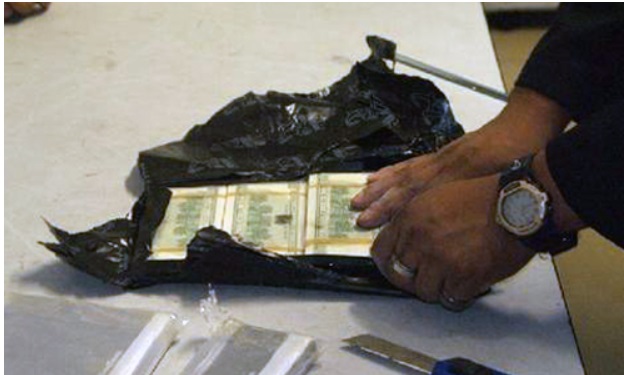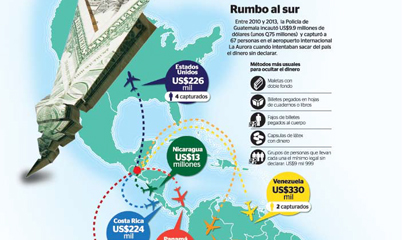
Runners hide money in suitcases, inside books, or concealed on their bodies. Photo courtesy of Prensa Libre archives.
The original version of this article was written in Spanish by Luis Ángel Sas and published on journalism platform CONNECTAS in May 2014.
Ecuadorean newscaster, psychologist and model María Magdalena Stahl Hurtado, a U.S. citizen of German heritage, strolled through the La Aurora airport in Guatemala one May afternoon in 2010. At almost 5'9″, her elegant figure was a magnet for the eyes.
Carlos, an anti-drug officer, was captured by Stahl's magnetic field; she had almost represented Ecuador in the Miss Universe pageant five years earlier. Carlos approached her for a routine screening for which passengers are randomly selected. Truth be told, his choice of Stahl was based more on her attractive figure than on any grounds for suspicion. But when he looked her in the eyes, he saw the fear characteristic of those who have something to hide.
He was trained for this. He began a barrage of questions; Stahl did not resist. Carlos asked to search her luggage; she objected, but had to give in. After several hours of counting, the Public Ministry calculated that there was $435,762 USD hidden in the luggage that Stahl was taking to Panama. According to the General Subdivision of Anti-Narcotics Information Analysis (SGDAIA), a total of $9.9 million USD was seized from passengers of various nationalities and profiles trying to transport undeclared money out of La Aurora International Airport between 2010 and 2013.
The latest reported case is that of Coatepeque soccer coach Richard Alexis Preza Herrera, who was arrested for transporting $14.6 million USD. At his trial he was fined 600,000 quetzals ($7,750 USD) and was prohibited from leaving the country. Of the past four years, 2011 saw the most money seized: a total of $5.7 million USD. The year before, in 2010, $2.2 million USD was confiscated. The total decreased to $859,000 in 2012 and reached $969,000 in 2013.
How money gets moved
The $9.9 million USD was confiscated from 67 individuals, an average of $147,000 per person. However, the amount carried by each person ranged from $12,000 to $1 million.

Credit: Prensa Libre.
Techniques for transporting hidden money also varied wildly: bills stuck in books and notebooks, hidden in the heels of shoes, stuffed into belts, or concealed on the body and secured with stockings or adhesive tape.
Money has also been concealed in cans of beans, in the false bottoms of suitcases masked with carbon paper, and even in the stomach, after being swallowed in latex capsules. “The only limit is the imagination,” says Rolando Rodenas, head of the·Anti-Money Laundering Prosecutors’ Office.
Rodenas says that there are other forms of getting money out of the country without the need to hide it, although these other methods leave a trail of evidence that may be sufficient to get the perpetrators caught.
“The law states that up to $10,000 USD can be transported without declaration. Thus there are people who travel with $9,700 or $9,800, just barely within the legal limit,” says Rodenas. At least two large groups of runners, each carrying legal amounts of money, have been caught transporting money to Panama, the primary destination for money laundering.
According to Rodenas, another way to transport money was to claim that the runners were managers or employees of businesses who were traveling to make deals or purchases. After months of investigation, it was determined that the businesses were only a cover and that they had no real financial activities. In fact, money launderers continue to use this method.
“That's how they're getting the money out of the country. They're doing what the law permits,” says Rodenas, who will not venture a guess as to the amounts of money that are taken out of the country illegally. “It's difficult to give a figure; a study would have to be performed,” he says.
Élmer Sosa, head of the SGDAIA, declined to be interviewed for this article. However, his staff at La Aurora International Airport estimate that the confiscated money represents only 10 percent of the amount that leaves the country in suitcases: “hidden or declared, but without legal ground,” claims an agent who requested anonymity.
A report from Global Financial Integrity (GFI) states that between 2002 and 2011, Guatemala moved 10 percent of Central America's total dirty money, which may be as much as $14 billion USD. Guatemala's illicit financial flow of $1.3 billion puts it in fourth place after Costa Rica (4.3 billion), Panama (3.9 billion), and Honduras (2.8 billion). El Salvador's illicit financial flow was $1 billion and Nicaragua's was $700 million.
“About two years ago, personnel identified some 45 people who were traveling with $9,800 or $9,700 on the same flight to Panama!” explains the agent.
This number seems believable after the capture of members of a group that the Public Prosecutor has baptized the Pitufos (the Smurfs), led by David Cervantes Urízar. According to the Prosecutors’ Office, this group alone coordinated 20 trips to Panama, laundering approximately $3 million per month.
Another trafficking group caught by the Prosecutors’ Office was one called Véliz-Palomo (the surnames of two members). The Prosecutors’ Office determined that over the course of a year, between 2010 and 2011, the group organized 20 trips per week to bring money to Panama. In 2012, a tribunal sentenced 48 members of the group to terms of 3 to 56 years behind bars.
A presiding court sent María Magdalena Stahl Hurtado to prison, which initiated a penal process for money laundering.
A few days later, judge Adrián Rolando Rodríguez Arana, of the Seventh Court of First Criminal Instance, let Stahl go free while the investigation continued. On March 29, 2011, Rodríguez Arana decided to indefinitely shelve the case and return the money to Stahl. The International Commission against Impunity sought an investigation into this action.
The money laundering route
According to the itineraries of detained runners, there are two clear routes used for transporting money via airports. The first is Guatemala-Panama. According to police records, 37 people transported $7.5 million USD on this route. Some were forced to return to Guatemala, where they were arrested upon arrival. “We cooperate with authorities in that country because people repeatedly try to take money there,” said Rodenas.
The second route is Guatemala-Colombia. Eleven people, carrying $1.2 million USD, tried to take this route.
The third is Guatemala-Costa Rica, where eight travelers were caught transporting $224,000 USD. There was also an attempt to transport more money to Venezuela, but that was only one case.
The authorities in El Salvador issued warnings after capturing various Guatemalans who managed to slip past La Aurora airport security but were detained in El Salvador as they attempted to leave for Panama. Of the 67 detained individuals, 37 percent are Guatemalan, 20 percent Colombian, and 10 percent Mexican.
El Salvador: another key stop for money laundering
More than $3 million USD has been confiscated in El Salvador's international airport in the last five years. Sixty-nine people have been caught.
According to the El Salvador police, 48 of the detained are foreigners, mainly from Guatemala and Mexico.
According to the detained individuals’ flight itineraries, there are two clear routes taken by those trying to take money out of El Salvador. Most frequently, travelers leave from Guatemala, stop in El Salvador, and then leave for Panama. A total of 38 percent of the detained travelers reported Panama as their final destination. The second frequent route starts in Mexico, stops in El Salvador, and ends in Colombia; 11 percent of the detained travelers intended to go to Colombia.
If the money is moving south, that means it's intended to pay for drugs that have already been sent or are going to be purchased. The final destination is Panama because that's the financial center of the world; there are a lot of banks. We think that that's why Panama is the most convenient location for drug traffickers established in Panama or Colombia to receive money and put it in banks,” says Marco Tulio Lima, chief of the Anti-Narcotics Division of El Salvador's National Civil Police.
Money laundering expert Daniel Rico, of the Washington-based think tank The Wilson Center, explains that criminal groups that illegally move cash via border crossings such as airports are “small criminal organizations that need to move cash urgently in order to make payments.”
Rico says that the transport of cash via airports is “the most primitive and vulnerable method of money laundering,” only used by organizations who do not have the financial and logistical means to use more sophisticated systems like the creation of false companies or the laundering of money by means of financial institutions.
The confiscations in El Salvador's airport are grounded in intuition. “We analyze the individual's origin and nationality, the payment method, the duration of stay, the intended destination. Our units study individual profiles; there are no full searches of the plane,” explains the head of the anti-narcotics unit in El Salvador. He adds that no El Salvadorian money laundering structures have been found, and that the existing groups are from other countries.
+ See this Spanish-language publication in Prensa Libre
+ Download diagram in PDF







1 comment